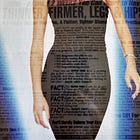Suspended Tendrils: The Story Behind the Crochet Art Series
Beginning with a Soft Reach: Building a Series from Gesture, Memory, and Material
The Suspended Tendrils series began the way a tendril does: not with a declaration, but with a gesture. A quiet reaching. A curve toward light. The earliest piece in the series, which I later titled Suspended Tendrils: Planting the Seed, lives in my own bedroom. It was never intended for an audience. I made it during a time when I needed my hands to do something steady, repetitive, and full of care.
It began with secondhand yarn and remnants, humble materials already marked by past use, and I let them guide me. I crocheted long, rippling forms without a fixed outcome. They started to spiral, to tangle, to rest beside one another in the way that growth sometimes happens in solitude. When I hung them on the wall, something shifted. The room felt held. Softer. Slightly more alive. This was the beginning, not of a finished piece, but of a language I wanted to keep speaking.
What Is Suspended Tendrils
Suspended Tendrils is a body of soft sculptural work that uses crochet to explore the architecture of emotion. Each piece in the series emerges through hyperbolic crochet, a mathematical technique that produces exponential growth and sculptural form through subtle increases in stitch count. This method produces organic ruffling, undulating waves, and forms that resist predictability. The work does not conform to flatness or order. It builds into itself. It defies linear containment.
The pieces are composed of salvaged yarns, textile fragments, and fibers that carry histories of previous use, typically hung on salvaged bamboo. They embrace the material realities of imperfection, reuse, and care. Each installation is spatially adaptive. The tendrils may be pinned in place, allowed to drape freely, or suspended from above. The forms are never fixed, because the meaning of the work is tied to context, interaction, and environment.
This flexibility makes the series a kind of soft infrastructure. It asks how sculptural form can reflect not only physical movement but also emotional calibration, sensory attunement, and social responsiveness. The work does not stand as a monument, but rather as a porous threshold, something that can open or shelter, depending on what is needed.
Suspended Tendrils 1
The second piece in the series, Suspended Tendrils 1, is the first to be exhibited publicly. It measures 120 inches tall by 44 inches wide and extends about 4 inches in depth. The piece has been invited into the International Fiber Arts XII Exhibition at Sebastopol Center for the Arts, a juried show that foregrounds contemporary, experimental textile work.
Before that, the piece was shown at the CCA Playspace Gallery in San Francisco in January 2025. I installed it as a soft curtain marking the entrance to a small room off the main gallery. Inside that room was Weave Yourself In, an interactive piece inviting visitor participation. Positioned in the threshold between public and private, Suspended Tendrils 1 offered a moment of transformation. It became a visual and tactile cue, gently signaling that one was crossing into a slower, more intimate space.
That installation taught me something essential about this work. The tendrils do not simply hang. They hold. They mediate. They absorb and reflect affective energy. They invite movement, but also ask for pause. They are not barriers, but they honor the need for boundaries.
On Hyperbolic Crochet
I am drawn to hyperbolic crochet because it mirrors emotional and cognitive experiences that are nonlinear, complex, and sometimes overwhelming. The technique itself is a kind of expansion logic. With each added stitch, the form increases in volume and folds in sometimes unpredictable ways. What results are soft structures that are alive with potential and at times, unruly.
There is something inherently resistant about this form. It does not lie flat. It takes up more space than expected. It demands dimensionality. I see this not just as an aesthetic choice, but as a way of challenging traditional hierarchies of form, function, and worth. In a culture that often rewards efficiency, containment, and order, hyperbolic crochet insists on excess, on texture, on unfolding.
This technique is not simply a method. It is a metaphor. It expresses the way feelings move. The way grief expands even when you try to tuck it away. The way sensory input can swell and crest. The way softness itself becomes a force.
Tendrils as Language
Tendrils are not ornamental. They are survival strategies. In the natural world, tendrils allow plants to attach, climb, stabilize. They move toward what they need. They are sensitive, responsive, and often underestimated.
In this series, the tendrils serve as a visual and conceptual language for vulnerability and agency. They evoke the embodied experience of reaching for connection, of navigating uncertainty, of stretching into the unknown with both caution and curiosity.
They also resist the binary of fragility and strength. A tendril can be both. It can coil around support or release entirely. It is capable of sustaining life and anchoring growth, even while appearing delicate.
As someone who moves through the world with both visible and invisible disabilities, this imagery resonates deeply. The tendrils are not ornamental frills. They are tools. They are negotiations. They are invitations.
A History of Shared Threads
The forms in this series are loosely rooted in a pattern I once followed for the 100 Women Project, a collaborative fiber installation that asked participants to crochet wisteria vines in celebration of individual strength and collective voice. That early experience of contributing a single tendril among many stayed with me. It gave me permission to see small, repetitive gestures as meaningful, not only in their accumulation, but in their uniqueness.
Early on, I also contributed to Something in the Water, a satellite of the Crochet Coral Reef project. I crocheted soft sculptural forms out of plastic bags, and my pieces became part of a larger eco-art installation. This experience expanded my understanding of crochet as a social, ecological, and political language. It was around that time that I was also writing about fiber art and craftivism on my blog, documenting the ways that softness, repetition, and care could serve as resistance, testimony, and transformation.
Suspended Tendrils grows from this lineage. It is a personal practice shaped by past participation in collaborative projects and a shared history of fiber-based resistance, care, and expression. While I create these pieces myself, they are informed by traditions of collective making and the possibilities of future participatory expansion.
Adaptability as Intention
Each work in this series is site-responsive. The tendrils can be arranged differently with each installation. They may hang in open space or be pinned into denser configurations. Some versions will invite movement through them. Others will remain still. This is not simply a practical feature. It is an ideological one.
Adaptability is a way of respecting space, bodies, and need. It is a way of refusing rigidity. It is a way of honoring that different viewers and different environments will require different modes of engagement.
The work does not ask to be interpreted one way. It invites negotiation. It allows for reinterpretation. It is not static. Neither is care.
From Seed to Series
Suspended Tendrils: Planting the Seed still hangs in my bedroom. It remains a quiet piece, never publicly exhibited, but deeply significant. It is where the language of this work first emerged, not with an audience in mind, but with the simple need to feel grounded, creative, and present.
The series has continued to grow, just as tendrils do. Each piece follows a similar rhythm, but no two are the same. They evolve with me, shaped by space, by time, by context, and by the needs that arise during the act of making.
They are soft things in a world that often favors hardness. They do not apologize for that. They do not shrink. They expand.
They reach.
If you read this far, perhaps you like my work. The work takes work. Please support it:











I love learning something new. Your description of your work of art is beautiful. Now I need to know more about Hyperbolic Crochet!